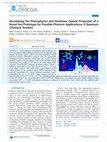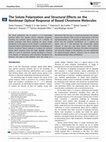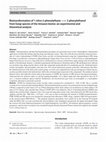Papers by Neidy Samara Sousa dos Santos
Chemical Physics Letters, 2025
Density Functional Theory and Hyper-Rayleigh Scattering were used to study the effect of proton a... more Density Functional Theory and Hyper-Rayleigh Scattering were used to study the effect of proton abstraction and of solvent environment on the nonlinear optical (NLO) response of five xanthones from Amazon biome. In gas phase, first hyperpolarizabilities range from 541 to 1277 au, surpassing benchmarks like urea (37 au) and p-nitroaniline (74 au), but even higher values were obtained when solvent is included. Proton abstraction enhances electron delocalization and favors intramolecular charge transfer. Our study also shows that proton abstraction can increase NLO signal by up to 21 times, with potential applications in organic light-emitting diodes.

ACS Omega, 2024
The photophysics and nonlinear optical responses of a novel nitrothiazol-methoxyphenol molecule w... more The photophysics and nonlinear optical responses of a novel nitrothiazol-methoxyphenol molecule were investigated using density functional theory (DFT) and time-dependent density functional theory (TD-DFT) methods with the polarizable continuum model to take the solvent effect into account. Special attention is paid to the description of the lowest absorption band, characterized as a strong π → π* state in the visible region of the spectrum. The TD-DFT emission spectrum analysis reveals a significant Stokes shift of more than 120 nm for the π → π* state in gas phase condition. The results show a great influence of the solvent polarity on the nonlinear optical (NLO) response of the molecule. Specifically, the second harmonic generation hyperpolarizability β(−2ω; ω, ω) shows a large variation from gas to aqueous solvent (82 × 10–30 to 162 × 10–30 esu), exhibiting notably higher values than those reported for standard compounds such as urea (0.34 × 10–30 esu) and p-nitroaniline (6.42 × 10–30 esu). Furthermore, a two-photon absorption analysis indicates a large cross-section (δ2PA = 77 GM) with superior performance compared to several dyes. These results make the molecule quite interesting for nonlinear optics.

Journal of Molecular Liquids, 2024
Free radicals are harmful reactive species that cause various problems in the human body. Antioxi... more Free radicals are harmful reactive species that cause various problems in the human body. Antioxidant compounds, such as xanthones found in natural products, can help prevent these effects. This study focuses on the antioxidant behavior of ravenelin (RVL) and ravenelin B (RVLB), a newly discovered xanthone in the Exserohilum rostratum fungus. Both experimental and in silico tests were conducted, comparing them to ascorbic acid, a standard antioxidant. The results showed that RVL has a lower bond dissociation energy (312 kJ/mol) than ascorbic acid (313 kJ/mol), indicating comparable antioxidant performance. This difference is mild but agrees with the experiment that indicates RVL efficiency is equivalent to ascorbic acid at low concentrations. RVLB, however, demands higher dissociation energy (323 kJ/mol) and consequently it has a lower antioxidative efficiency. Thus, antioxidant capacity is found as RVL > ascorbic acid > RVLB. From experimental assays, the RVL performance was confirmed through experimental tests at different solute concentrations. The study also examines the effects of solvents and intramolecular hydrogen bonds. Ravenelin molecules present three hydroxyl groups involved in intramolecular OH⋯O interactions. However, analysis based on the infrared spectra, as well as Bader’s theory and non-covalent interactions done in water solvent showed that the two strongest H-bonds (≈ −37 kJ/mol) better stabilize the molecular structure, but are not favorable to antioxidant reactions, indicating that hydrogen scavenging occurs at the less hydrogen-bonded hydroxyl group. The solvent also plays an active role first in facilitating hydrogen abstraction besides changing the hydrogen scavenging mechanism according to the environmental polarizability. Additionally, the antioxidant mechanism of ravenelin molecules changes from nonpolar to polar solvents, allowing for hydrogen abstraction.

The Journal of Physical Chemistry A, 2023
This work discusses the electron structure, antioxidative properties, and solvent contribution of... more This work discusses the electron structure, antioxidative properties, and solvent contribution of two new antioxidant molecules discovered, named S10 and S11, extracted from a medicinal plant called Vatairea guianensis, found in the Amazon rain-forest. To gain a better understanding, a study using density functional theory coupled with the polarizable-continuum model and the standard 6-311++G(d,p) basis set was conducted. The results indicate that S10 has a higher antioxidant potential than S11, confirming the experimental expectations. In the gas phase, the hydrogen atom transfer route dominates the hydrogen scavenging procedure. However, in the water solvents, the antioxidant mechanism prefers the sequential proton loss electron transfer mechanism. Furthermore, the solvent plays a fundamental role in the antioxidant mechanism. The formation of an intramolecular OH···OCH3 hydrogen bond is crucial for accurately describing the hydrogen scavenging phenomenon, better aligning with the experimental data. The results suggest that the two isoflavones investigated are promising for the pharmacologic and food industries.

Optik, 2023
The search for new materials with improved nonlinear optical (NLO) response is a field of growing... more The search for new materials with improved nonlinear optical (NLO) response is a field of growing interest in materials science. Typically, the dipole 𝛷𝐽=1 contributions exceed the octupolar 𝛷𝐽=3 ones and dominate the optical behavior. However, the latter is essential for NLO device engineering. Under this scenario, this work investigates the electronic-optical properties of the 𝛼-terpinolene and 𝛽-phellandrene molecules within the Hyper-Rayleigh scattering formalism (HRS). It includes solvent contributions using a sequential Monte Carlo/Quantum Mechanics procedure. According to Density Functional Theory analysis, molecular solvatochromism acts differently for the two chromophores. While 𝛼-terpinolene undergoes a hypsochromic effect, the 𝛽-phellandrene molecule shows moderate bathochromism, both with a strong absorption band in the ultraviolet region (𝜆max < 240 nm), making them attractive for potential UV filters. Regarding the NLO response, both compounds present similar values for the first frequencydependent hyperpolarizability (𝛽HRS) with values that vary from 62.46 to 138.73 au in aqueous environment, superating urea (𝛽 = 42.82 au), a standard optical material. Furthermore, while one of these chromophores is best described by dipole contributions (𝛷𝐽=1 ≈ 68%), the other is dominated by the octupolar term (𝛷𝐽=3 ≈ 60%) even when the solvent moderates it. These characteristics allow the building of optical switches without losing the strength of the NLO response. In addition, the polarization of the solute due to the solvent conveniently reduces the refractive index (𝑛), providing light conduction applications. Therefore, these chromophores can be used to promote a decoupling between dipolar and octupolar contributions in NLO.

ChemPhysChem, 2023
The solute polarization due to solvent is a an electrostatic quantum effect that impacts diverse ... more The solute polarization due to solvent is a an electrostatic quantum effect that impacts diverse molecular properties, including the nonlinear optical response of a material. An iterative procedure that allows updating the solute charge distribution in the presence of the solvent is combined with a sequential Monte Carlo/Quantum Mechanics methodology and Density Functional Theory methods to evaluate the nonlinear optical (NLO) response using the hyper Rayleigh scattering (HRS) of a series of chromones recently identified in Chamaecrista diphylla, an herbaceous plant abundant throughout the Americas and used in folk medicine. From this study, it is determined that from gas to solvent environment, the systems acquire low refractive index (n) and an improvement of the first hyperpolarizability (βHRS), signaling potential NLO uses. It is shown that the octupolar contributions (βJ=3) superate the dipolar ones (βJ=1) and dominate the second‐order optical response in both gas and liquid phases, which indicate nontrivial optical materials. Moreover, the solvent environment and structural changes in the periphery can tune significantly the dipolar/octupolar balance, showing a key to control the decoupling between these contributions.

Journal of Molecular Modeling, 2023
Context: Natural products and their biotransformation procedures are a powerful source of new chr... more Context: Natural products and their biotransformation procedures are a powerful source of new chromophores with potential applications in fields like biology, pharmacology and materials science. Thus, this work discusses about the extraction procedure of 1-nitro-2-phenylethane (1N2PE) from Aniba canelilla, its biotransformation setup into 2-phenylethanol (2PE) using four fungi, Lasiodiplodia caatinguensis (phytopathogenic fungus from Citrus sinensis), Colletotrichum sp. (phytopathogenic fungus from Euterpe oleracea), Aspergillus flavus and Rigidoporus lineatus isolated from copper mining waste located in the interior of the Brazilian Amazon. A detailed experimental and theoretical vibrational analysis (IR and Raman) have allowed us to perform some charge transfer effects on the title compounds (push-pull effect) by monitoring specific vibrational modes of their electrophilic and nucleophilic molecular sites. The solvent interactions promote molecular conformations that affect the vibrational spectra of the donor and acceptor groups, as can be seen comparatively in the gas and aqueous solution spectra, an effect possibly related to the bathochromic shift in the calculated optical spectrum of the compounds. The nonlinear optical behavior shows that while the solvent reduces the response of 1N2PE, the response of 2PE increases the optical parameters, which presents low refractive index (n) and first hyperpolarizability. ([Formula: see text]) is almost eight times that reported for urea (42.79 a.u.), a common nonlinear optical material. Furthermore, the bioconversion goes from an electrophilic to a nucleophilic compound, affecting its molecular reactivity. Methods: 1N2PE was obtained from Aniba canelilla, whose essential oil is constituted of [Formula: see text] of 2PE. The A. canelilla essential oil was extracted under hydrodistillation. The biotransformation reactions were performed in autoclaved liquid media (100 mL) composed of malt extract (2%) in 250 mL Erlenmeyer flask. Each culture was incubated in an orbital shaker (130 rpm) at [Formula: see text]C during 7 days and after that, 50 mg of 1N2PE (80%) were diluted in 100 [Formula: see text]L of dimethylsulfoxide (DMSO) and added to the reactions flasks. Aliquots (2 mL) were removed using ethyl acetate (2 mL) and analyzed by GC-MS (fused silica capillary col1umn, Rtx -5MS 30 m [Formula: see text] 0.25 mm [Formula: see text] 0.25 [Formula: see text]m) in order to determine the amount of 1N2PE biotransformation. FTIR 1N2PE and 2PE spectra were obtained by attenuated total reflectance (ATR), using a Agilent CARY 630 spectrometer, in the spectral region 4000-650 cm[Formula: see text]. The quantum chemical calculations were carried out in the Gaussian 09 program while the DICE code was used to perform the classical Monte Carlo simulations and generate the liquid environment using the classical All-Atom Optimized parameters for Liquid Simulations (AA-OPLS). All nonlinear optical properties, reactive parameters, and electronic excitations were calculated using the Density Functional Theory framework coupled to the standard 6-311++G(d,p) basis set.










Uploads
Papers by Neidy Samara Sousa dos Santos